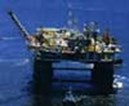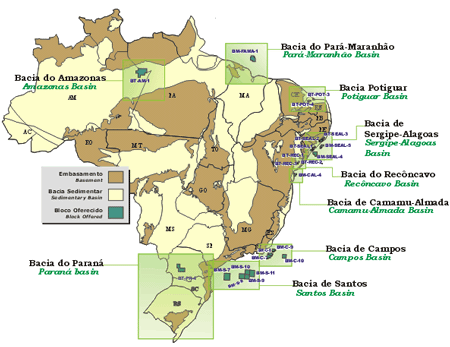Second Bidding Round Highlights Booming Brazil Upstream

by Ben Backwell, Rio de Janeiro
Contents
June Bidding
New Players New Partnerships
Petrobras
With oil at $30 per barrel and little possibility of further opening in Latin America's only OPEC country Venezuela, formerly unglamorous Brazil has taken center stage as a key province in many companies' Latin American portfolios.
Even before the first bid was made at the Brazilian Petroleum Agency's (ANP) second licensing round, the tender had already shaped up as a sweepstakes for oil companies interested in the region's hottest investment play. Brazil is auctioning the leases in an effort to lure new investment to the country's E&P sector and foster competition in Brazil's oil industry.
June Bidding(Back to Top)
 sulOn May 24th, the ANP announced that it had approved 44 domestic and foreign companies to bid for 23 oil and gas exploration blocks located on and offshore in some of the country's most promising sedimentary basins. Qualifying bidders included Repsol-YPF, Shell, and Agip—all of whom had burst onto Brazil's oil scene following the government's dismantling of Petrobras' virtual monopoly of the sector. Other qualified companies included 16 from the USA, among them ExxonMobil Corp. and Texaco, and 10 from Europe, including the Royal Dutch/Shell Group. Companies from Germany, France, Italy, Spain, Portugal, and Denmark have also qualified.
sulOn May 24th, the ANP announced that it had approved 44 domestic and foreign companies to bid for 23 oil and gas exploration blocks located on and offshore in some of the country's most promising sedimentary basins. Qualifying bidders included Repsol-YPF, Shell, and Agip—all of whom had burst onto Brazil's oil scene following the government's dismantling of Petrobras' virtual monopoly of the sector. Other qualified companies included 16 from the USA, among them ExxonMobil Corp. and Texaco, and 10 from Europe, including the Royal Dutch/Shell Group. Companies from Germany, France, Italy, Spain, Portugal, and Denmark have also qualified.
Indeed, analysts noted that the ANP's releasing of the list of companies approved for the bidding just went to show that outfits continue to ride high on sentiment for the country's exploration and production potential. More than this, the ANP lists turned the spotlight on the ambitions of independent oil and gas exploration companies from abroad. This segment of bidders included six Brazilian oil upstream investment ventures and E&P companies, besides other outfits from Canada, Argentina, Australia, South Korea, China, and Japan. The 23 offshore and onshore blocks contracts covered an area of 59,000 square kilometers.
Moreover, the ANP designed the auction of the 23 areas to favor smaller companies after the majors took center stage at last year's bidding round. The regulator had nearly halved the size of the blocks—compared to the June landmark auction—to make it easier for firms to pinpoint oil and gas deposits.

The agency also offered more manageable areas with varied terrain to attract smaller independent firms along with the major oil companies. Moreover, the ANP enshrined a much-cheered "out-clause" on several under-developed blocks in the Sergipe-Alagoas, Potiguar, and Reconcavo Basins to give bidders a year to study the acreage before committing beyond the auction price.
New Players New Partnerships(Back to Top)
But the ANP is really just the icing on the cake for Brazil's oil sector as companies are gearing up to new partnerships with Petrobras and take part in two forthcoming tenders for marginal fields. Royal Dutch Shell's Brazilian unit, which is qualified to bid in the licensing round, is still open to further partnerships with the federally controlled oil company, Petrobras. The unit's vice president for Exploration and Production, Phil Hanson, recently said that beside its on going focus on Brazilian deepwater terrain, where it boasts hefty upstream credentials, the company would be interested in new joint ventures with Petrobras as they presented themselves.
After recently winning rights to a field in Argentina's Neuquen Basin, Canadian Hunter is bidding in the June auction, and also plans to seek out opportunities in Brazil's less developed northeastern region.
"We are very interested in evaluating opportunities in Brazil. We have bought the data packages for NE Brazil and are currently evaluating it," said a Canadian Hunter official, who added that Canadian Hunter would be most focused on northeastern Brazil which industry sources say may develop into one of the region's most important gas plays.
Meanwhile, another company, US-based Unocal, hopes to turn its Brazilian portfolio into a moneymaker in the coming years.
"Brazil is a core area for Unocal. It has a lot of strategic value, notably because of its oil rich basins that fit our profile as a company," said Unocal Brazil's director Sergio Brandao.
Unocal was a surprise no show for the ANP auction, and plans to develop its existing Brazilian assets and has also said the company would be open to further partnerships with the state-run company.
 The Latin Iberian energy titan Repsol-YPF and the UK's top independent company, Enterprise Oil, are also separately evaluating the ANP's data for the round and other opportunities in Brazil. Both companies have been on a Brazilian shopping spree and are interested in building up their E&P portfolio here.
The Latin Iberian energy titan Repsol-YPF and the UK's top independent company, Enterprise Oil, are also separately evaluating the ANP's data for the round and other opportunities in Brazil. Both companies have been on a Brazilian shopping spree and are interested in building up their E&P portfolio here.
John Shute, Enterprise's New Business manager, said that the company was evaluating the blocks on offer as well. "We have them under technical analysis," he said. Moreover, Shute noted that the company hoped to add discovered oil to its Brazilian assets.
"We've been building up our Brazil portfolio with BC-2, BCe-2, and Bijupirá-Salema. We want a set of assets that go beyond an exploration portfolio. It is always our intention to have discovered oil, along with exploration acreage, to give us that life cycle," he said.
Companies which already have acreage in Brazil, are unveiling ambitious development plans. New players plan to drill 21 wells this year. British Petroleum, Coastal, Elf, Pennzenergy, Petrobras, Queiroz Galvao, Santa Fe, Shell, Sipetrol, Texaco, Union Pacific, and YPF are preparing to begin drilling operations between the second and fourth quarters of 2000.
The oil group Repsol-YPF will begin drilling in some of its shallow water terrain, said the company's E&P director Mateo Turic. This includes two wells for BES-3 and 2 wells in BPOT-2.
"If the wells in BES-2 are successful, then we'll begin with a development plan for the block in earnest next year," he said, "and it would be a fairly quick development, while we'd like to start producing around 2002."
The company has acreage in the basins, Espirito Santo, Portiguar, Campos, and Camamu-Almada. Investments should run around US$500 million over the next five years.
Petrobras(Back to Top)
State oil company Petrobras, far from being left behind by the new influx of private companies drilling for oil, has stepped back and is focusing on a series of core mega projects which will bring its oil production in Brazil past the 1.3 million b/d mark within five years. It hopes to close in the coming months project financing for Espadarte/Voador/Marimba and the Albacora Fields, which total some $4.1 billion. Financing for the fields is being negotiated with various Japanese trading companies.
 Espadarte/Voador/Marimba involves credit lines of $1.2 billion and is being negotiated with Mitsui and Marubeni. The financing structure of the deal is being based on finance leasing, as was the offshore Cabiúnas gas project. The $400 million Albacora project will be closed with Nissho Iwai.
Espadarte/Voador/Marimba involves credit lines of $1.2 billion and is being negotiated with Mitsui and Marubeni. The financing structure of the deal is being based on finance leasing, as was the offshore Cabiúnas gas project. The $400 million Albacora project will be closed with Nissho Iwai.
The sheer size of financing plans reflects Petrobras' ambitions to feed crude oil and natural gas to fuel hungry markets in Brazil and clearly underscores the scope of the company's ambitions on the global financing stage. This will put the spotlight on Petrobras plans to seek out financing for the $1.43 billion Roncador and the $1.285 billion Marlim Sul crude oil and natural gas projects.
Roncador has an estimated 3 billion bbl (including oil and natural gas) and is one of the company's most promising production prospects. The company is expected to create a special purpose company to be formed by creditors to obtain the necessary finances from investors in the market. Funds will be largely used to for the construction of production facilities to be used by Petrobras. The special purpose company will receive future oil production as payment for its contribution.
The first of four modules in Petrobras' Marlim Sul Field, in the deepwater Campos Basin, is due on stream in the second half 2000. First phase development, targeting 340 million bbl of oil in a portion of the field, will entail 30 wells connected to a floating production unit (FPU), which in turn will be linked to a floating storage and offloading (FSO) unit.

Petrobras plans to spend $400 million this year alone and $1.2 billion by 2003 to develop this part of the field, not including the cost of leasing the FPU and FSO.
Of the 30 wells, 17 will be producers and 13 water injectors. Production is expected to start up in 2003 and peak at a level of about 148,000 b/d of oil and 2.5 million cm/d of natural gas. Marlim Sul was discovered in 1987 and could hold oil reserves of up to 2 billion bbl. The project calls for drilling 110 wells in all, 59 production and 51 injection.
Symptomatic of the scale of Petrobras' projects are the series of giant floating production platforms which have been arriving in Brazilian waters.
Petrobras began production from the P-36 oil platform in the Campos Basin in early May. The P-36 is the world's largest semisubmersible based FPS, with production capacity of 180,000 b/d. The first well to enter into production will be the Roncador-9 (RO-9), whose capacity should reach up to 15,000 b/d and 285,000 cm/d of gas. By the end of the year, four other production wells at Roncador, including Roncador-8 and RJS-436A—currently producing for the Seillean FPSO Early Production System—are scheduled to be onstream with a production of 75,000 b/d and 1.4 million cm/d of gas. In all, 26 wells will be drilled while peak production at Module 1 should occur in 2003, reaching some 180,000 b/d and 4 million cm/d gas.
